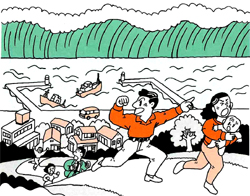サイト内検索
本文
First you should know that survival is not luck.
You can survive an earthquake and minimize its damage simply by becoming aware of potential hazards and taking some basic precautions.
Develop a family earthquake plan.

- When you feel an earthquake, open a door right away. This ensures an escape route after the earthquake is over.
- Elevators → Press the Emergency button and alight at the floor at which the elevator stops.
- Usually a strong earthquake will end within a minute or so.
- Seek shelter in the room you're in and stay there until it's over.
あわてず冷静に火災を防ぐ

1)Extinguish any open flames the moment you feel an earthquake.
- Be quick to turn off any heat sources in use such as gas burners and heating stoves.
- Turn off the stopcock of gas appliances and unplug electrical appliances.
- When evacuating after an earthquake is over, make sure to switch off the circuit breaker.(Electrical appliances that have fallen down due to an earthquake might possibly contact inflammable articles scattered around there and cause a fire.)
2)Put out any fires that may have started.
- Use water or a fire extinguisher to put them out.
- Shout "Kaji"(fire) to notify your neighbors and get their assistance.
狭い路地、塀ぎわ、崖や川べりに近寄らない

- Don't stand under the eaves of homes or buildings because roofing tiles,bricks,glass,or concrete may fall on you.
- Stay away from cliffs and river banks because the ground there may have loosened,making a landslide possible.

1)Evacuate on foot with a minimal amount of personal belongings.
- Evacuate on foot.
- Wear comfortable,loose clothing.
- Carry only necessary personal belongings on your back.
2)"Tsunami"(Tidal waves caused by earthquakes).

Evacuate to a safe place such as higher ground,a tsunami evacuation area or a tsunami evacuation building when you feel either a strong earthquake(degree 4 or higher on the seismic scale) or a weaker but lasting tremor.
Listen to the radio for news concerning "Tsunami".
3)Get away from the bottoms of mountains and cliffs.
There is a danger of landslides or slope failure ata the feet of hills or in steep slope areas. Make up your mind quickly to get away from such dangerous areas. Also follow evacuation instructions given by the municipality.
| 避難所 Evacuation Centers |
|
Evacuation centers are where you escape after a large earthquake or typhoon. These are usually public buildings, such as schools or community centers,and are open to everyone. The centers provide food, drink, a place to sleep and information (announcements). Check the location of your neighborhood evacuation center before a disaster occurs.
|
正しい情報の入手を


- Don't be misled by rumors or groundless information. Follow the news on TV or radio.
- Follow instructions given by municipal offices and fire and police departments, as well as via disaster preparedness broadcasts.
- Don't use a telephone unnecessarily. Calling the fire department, etc. to seek news on disaster status can affect their activities.
協力しあって応急救護を

Provide first aid for slightly injured people in cooperation with others.
If there are many injuries, emergency services may not be able to handle all of the cases. In order to acquire first aid skills, please take part in first aid lecture meetings held by fire stations and other competent organizations.
協力しあって救出活動を

- If you find a person pinned under a collapsed structure or a fallenobject, jyoin forces with other communitya members forresucue activities.

自動車の運転中では

- Immediately pull over to the side of the road or into a vacant lot and turn off your engine.

- Listen for news on the radio.
- Follow the instructions of the police.
- Evacuate on foot, leaving the key in the car.
避難のテクニック
まず落ち着いて身の安全を
- Prevention of fires.
- Stay away from narrow streets, walled streets, cliffs and river banks.
- Evacuation procedure.
- Be sure that the information you receive is correct.
- Join forces for first aid.
- Join forces for rescue.
- What to do when driving car.




